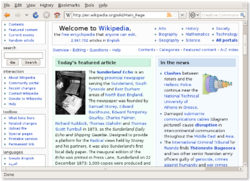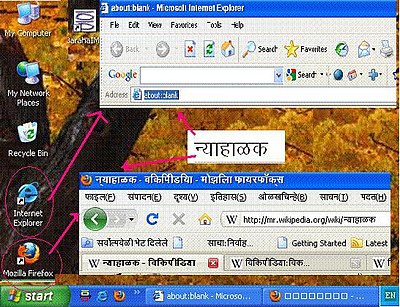आंतरजाल न्याहाळक
आंतरजालावर मुशाफिरी करण्यासाठी लागणारी संगणक आधारीत प्रणाली

न्याहाळक [विशिष्ट अर्थ पहा] (वेब न्याहाळक) हा एक software application for retrieving, presenting, and traversing information resources on the World Wide Web. An information resource is identified by a Uniform Resource Identifier (URI) and may be a web page, image, video, or other piece of content.[१] Hyperlinks present in resources enable users to easily navigate their browsers to related resources.

Although browsers are primarily intended to access the World Wide Web, they can also be used to access information provided by web servers in private networks or files in file systems.
मुख्य न्याहाळक आहेत इंटरनेट एक्सप्लोरर, फायरफॉक्स, सफारी, गुगल क्रोम व ओपेरा.
इतिहास
संपादनThe history of the web browser dates back to the late 1980s, when a variety of technologies laid the foundation for the first web browser, WorldWideWeb, by Tim Berners-Lee in 1991. That browser brought together a variety of existing and new software and hardware technologies.
The introduction of the NCSA Mosaic web browser in 1993 – one of the first graphical web browsers – led to an explosion in web use. Marc Andreessen, the leader of the Mosaic team at NCSA, soon started his own company, named Netscape, and released the Mosaic-influenced Netscape Navigator in 1994, which quickly became the world's most popular browser, accounting for 90% of all web use at its peak (see usage share of web browsers).
मायक्रोसॉफ्टनेही इंटरनेट एक्सप्लोरर हा वेब न्याहाळक १९९५ मधे काढला. (also heavily influenced by Mosaic), initiating the industry's first browser war. By bundling Internet Explorer with Windows, Microsoft was able to leverage its dominance in the operating system market to take over the web browser market; Internet Explorer usage share peaked at over 95% by 2002.[३]
ओपेरा हा वेब न्याहाळक १९९६ मधे सुरू झाला. although it has never achieved widespread use, having 2% browser usage share as of August 2009 according to Net Applications,[४] it has a substantial share of the fast-growing mobile phone web browser market, being preinstalled on over 40 million phones. It is also available on several other embedded systems, including Nintendo's Wii video game console.
In 1998, Netscape launched what was to become the Mozilla Foundation in an attempt to produce a competitive browser using the open source software model. That browser would eventually evolve into Firefox, which developed a respectable following while still in the beta stage of development; shortly after the release of Firefox 1.0 in late 2004, Firefox (all versions) accounted for 7.4% of browser use.[३] As of August 2009, Firefox has a 23% usage share.
Apple's Safari had its first beta release in January 2003; as of July 2009, it has a dominant share of Apple-based web browsing, accounting for just over 4% of the entire browser market.[४] Its rendering engine, called WebKit, is also running in the standard browsers of several mobile phone platforms, including Google Android, Nokia S60 and Palm WebOS.
The most recent major entrant to the browser market is Google's WebKit-based Chrome, first released in September 2008. As of August 2009, it has a 3% usage share.
Function
संपादनThe primary purpose of a web browser is to bring information resources to the user. This process begins when the user inputs a Uniform Resource Identifier (URI) , into the browser. The prefix of the URI determines how the URI will be interpreted. The most commonly used kind of URI starts with http: and identifies a resource to be retrieved over the Hypertext Transfer Protocol (HTTP). Many browsers also support a variety of other prefixes, such as https: for HTTPS, ftp: for the File Transfer Protocol, and file: for local files. Prefixes that the web browser cannot directly handle are often handed off to another application entirely. For example, mailto: URIs are usually passed to the user's default e-mail application, and news: URIs are passed to the user's default newsgroup reader.
In the case of http, https, file, and others, once the resource has been retrieved the web browser will display it. HTML is passed to the browser's layout engine to be transformed from markup to an interactive document. Aside from HTML, web browsers can generally display any kind of content that can be part of a web page. Most browsers can display images, audio, video, and XML files, and often have plug-ins to support Flash applications and Java applets. Upon encountering a file of an unsupported type or a file that is set up to be downloaded rather than displayed, the browser prompts the user to save the file to disk.
Information resources may contain hyperlinks to other information resources. Each link contains the URI of a resource to go to. When a link is clicked, the browser navigates to the resource indicated by the link's target URI, and the process of bringing content to the user begins again.
Features
संपादनAvailable web browsers range in features from minimal, text-based user interfaces with bare-bones support for HTML to rich user interfaces supporting a wide variety of file formats and protocols. Browsers which include additional components to support e-mail, Usenet news, and Internet Relay Chat (IRC), are sometimes referred to as "Internet suites" rather than merely "web browsers".[५][६]
All major web browsers allow the user to open multiple information resources at the same time, either in different browser windows or in different tabs of the same window. Major browsers also include pop-up blockers to prevent unwanted windows from "popping up" without the user's consent.[७][८][९]
Most web browsers can display a list of web pages that the user has bookmarked so that the user can quickly return to them. Bookmarks are also called "Favorites" in Internet Explorer. In addition, all major web browsers have some form of built-in web feed aggregator. In Mozilla Firefox, web feeds are formatted as "live bookmarks" and behave like a folder of bookmarks corresponding to recent entries in the feed.[१०] In Opera, a more traditional feed reader is included which stores and displays the contents of the feed.[११]
Furthermore, most browsers can be extended via plug-ins, downloadable components that provide additional features.
User interface
संपादनMost major web browsers have these user interface elements in common:
- Back and forward buttons to go back to the previous resource and forward again.
- A refresh or reload button to reload the current resource.
- A stop button to cancel loading the resource. In some browsers, the stop button is often merged with the reload button.
- A home button to return to the user's home page
- An address bar to input the Uniform Resource Identifier (URI) of the desired resource and display it.
- A search bar to input terms into a search engine
- A status bar to display progress in loading the resource and also the URI of links when the cursor hovers over them, and page zooming capability.
Major browsers also possess incremental find features to search within a web page.
Privacy and security आणि सुरक्षा
संपादनMost browsers support HTTP Secure and offer quick and easy ways to delete the web cache, cookies, and browsing history. For a comparison of the current security vulnerabilities of browsers, see comparison of web browsers.
Standards support
संपादनEarly web browsers supported only a very simple version of HTML. The rapid development of proprietary web browsers led to the development of non-standard dialects of HTML, leading to problems with interoperability. Modern web browsers support a combination of standards-based and de facto HTML and XHTML, which should be rendered in the same way by all browsers.
हे सुद्धा पहा
संपादनलेखात प्रयूक्त संज्ञा
संपादनशब्दाचा विशेष संदर्भ/अर्थ छटा
संपादन| प्रयूक्त शब्द | विशेष संदर्भ/अर्थ छटा |
| browser | विचरक/न्याहाळक |
इंग्रजी मराठी संज्ञा
संपादन| web | मराठी | ||
| Layout engine | मराठी | ||
| Internet suite | मराठी | ||
| HTML | मराठी | ||
| XHTML | मराठी | ||
| page zooming | मराठी | ||
| status bar | मराठी | ||
| address bar | मराठी | ||
| home page | मराठी | ||
| refresh or reload | मराठी | ||
| User interface | मराठी | ||
| plug-ins | मराठी | ||
| Back and forward buttons t | मराठी | ||
| tabs | मराठी | ||
| browser windows | मराठी | ||
| pop-up blockers | मराठी | ||
| hyperlinks | मराठी | ||
| Uniform Resource Identifier | मराठी | ||
| Hypertext Transfer Protocol | मराठी | ||
| applets | मराठी | ||
| embedded system | मराठी | ||
| beta stage of development | मराठी | ||
| World Wide Web | मराठी | ||
| web servers | मराठी | ||
| private networks | मराठी | ||
| file systems | मराठी | ||
| इंग्रजी | मराठी | ||
| इंग्रजी | मराठी | ||
| इंग्रजी | मराठी | ||
| इंग्रजी | मराठी | ||
| इंग्रजी | मराठी | ||
| इंग्रजी | मराठी | ||
| इंग्रजी | - | इंग्रजी | मराठी |
| इंग्रजी | मराठी | ||
| इंग्रजी | मराठी |
References
संपादन- ^ Jacobs, Ian. "URI/Resource Relationships". Architecture of the World Wide Web, Volume One. 30 June 2009 रोजी पाहिले.
- ^ Stewart, William. "Web Browser History". 5 May 2009 रोजी पाहिले.
- ^ a b http://www.searchenginejournal.com/mozilla-firefox-internet-browser-market-share-gains-to-74/1082/
- ^ "The SeaMonkey Project". 30 June 2009 रोजी पाहिले.
- ^ "Cyberdog: Welcome to the 'doghouse!". 1998-12-12 रोजी मूळ पान पासून संग्रहित. 30 June 2009 रोजी पाहिले.
- ^ Andersen, Starr. "Part 5: Enhanced Browsing Security". Changes to Functionality in Microsoft Windows XP Service Pack 2. 30 June 2009 रोजी पाहिले.
- ^ "Pop-up blocker". 2010-09-27 रोजी मूळ पान पासून संग्रहित. 30 June 2009 रोजी पाहिले.
- ^ "Simple settings". Opera Tutorials. 30 June 2009 रोजी पाहिले.
- ^ Bokma, John. "Mozilla Firefox: RSS and Live Bookmarks". 30 June 2009 रोजी पाहिले.
- ^ "RSS newsfeeds in Opera Mail". 2012-01-19 रोजी मूळ पान पासून संग्रहित. 30 June 2009 रोजी पाहिले.
